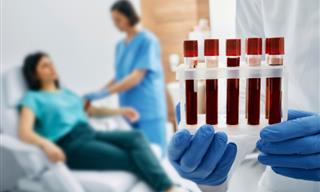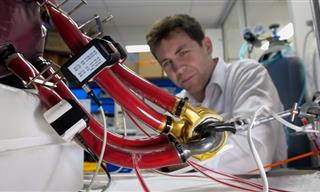A high PSA level can be an indicator of prostate cancer, but it can also result from less serious conditions. A prostate-specific antigen (PSA) test is a diagnostic tool used to screen for prostate cancer, a disease that affects the prostate gland located between the bladder and the penis in men. According to the Urology Care Foundation, doctors may recommend this test if you exhibit symptoms such as an enlarged prostate, pain in the lower pelvic area, frequent urination, or difficulty while urinating.
In addition to symptoms, your doctor may suggest a PSA test as part of routine care, especially if you're over a certain age or have risk factors for prostate cancer. The test works by measuring the level of PSA, a protein produced by both normal and cancerous prostate cells, in the blood. According to the National Cancer Institute (NCI), higher PSA levels can suggest the presence of prostate cancer, but the test is not foolproof. Some individuals may have elevated PSA levels without cancer, leading to false positives. Keep reading to explore common reasons, beyond prostate cancer, that could cause elevated PSA levels.
Testing for Prostate Cancer
Prostate cancer is the second leading cause of cancer-related deaths among men in the United States, just behind lung cancer, according to the American Cancer Society (ACS). While many prostate cancers grow slowly and remain confined to the prostate gland, some are more aggressive. Since early-stage prostate cancer often shows no symptoms, PSA screening can help in detecting cancer before it spreads, improving the chances of successful treatment.

However, the PSA test has its limitations. According to the ACS, a higher PSA level does not definitively prove the presence of cancer, and a lower level doesn’t guarantee its absence. False positives can occur when elevated PSA levels stem from other conditions. In some cases, prostate cancer may be so slow-growing that treating it could cause more harm than benefit, leading to a risk of overtreatment.
In light of these complexities, the American Urological Association advises against PSA testing for men under 40 due to the lack of proven benefits. For men aged 40 to 54, routine screening is also discouraged unless individual risk factors are present, such as being over 50, being of African American or Caribbean descent, or having a family history of prostate cancer. Dr. Amin Herati of Johns Hopkins Medicine notes that screening is typically recommended for men between 55 and 69, particularly those at higher risk, and aligns with guidelines from the U.S. Preventive Services Task Force. PSA tests are also useful for monitoring cancer recurrence after treatment.
There is no universal agreement among healthcare providers on the best timing for prostate cancer screening, and recommendations may evolve. It’s essential to have an informed discussion with your doctor about the risks and benefits of PSA testing before proceeding.
Noncancerous Causes of a High PSA Test Result
A high PSA result doesn’t always mean cancer. There are several reasons why PSA levels might be elevated, including:
1. Aging

As men age, their PSA levels naturally tend to rise, even in the absence of any underlying prostate problems. This increase is largely due to the changes in prostate tissue over time. The prostate gland enlarges with age, which can contribute to a gradual rise in PSA production. This is a normal process and does not necessarily indicate cancer.
Doctors use age-based cutoffs to determine what constitutes a “normal” PSA level. For instance, PSA levels above 2.5 nanograms per milliliter (ng/mL) are considered abnormal for men in their 40s and 50s, while levels above 4.0 ng/mL are more concerning in men in their 60s and beyond. These values, however, are not set in stone—what's more important is the rate at which PSA levels increase over time. Even if a PSA reading is within the normal range, a rapid rise from one year to the next could signal an underlying issue, prompting doctors to investigate further.
This gradual increase with age makes it essential for doctors to evaluate PSA results in the context of a patient’s age and personal health history. In many cases, an elevated PSA level in an older man might simply be due to natural aging, but it still warrants careful monitoring over time to rule out other conditions.
2. Prostatitis

Prostatitis is an inflammation of the prostate gland, and it is one of the most common causes of elevated PSA levels, especially in younger men. The Prostate Cancer Foundation reports that up to 50% of men will experience prostatitis at least once in their lifetime, making it a widespread concern.
There are different types of prostatitis, and each can affect PSA levels differently:
Acute bacterial prostatitis is caused by bacterial infection and often presents with sudden symptoms such as fever, chills, pain in the lower abdomen, and difficulty urinating. Antibiotics are typically effective in treating this form of prostatitis.
Chronic bacterial prostatitis is a longer-lasting bacterial infection that may be more difficult to treat. Symptoms can be milder than in acute cases but are often persistent, leading to long-term discomfort and elevated PSA levels.
Chronic pelvic pain syndrome (CPPS) or nonbacterial prostatitis is the most common form and is not caused by an infection. Its symptoms include chronic pain in the pelvic region, painful urination, and general discomfort in the prostate area. Nonbacterial prostatitis can be more challenging to treat, as the exact cause is often unknown. Factors such as inflammation, nerve damage, muscle spasms, or stress may play a role in its development.
Because prostatitis involves inflammation, it can lead to significant PSA elevation, which may be mistaken for signs of prostate cancer. When prostatitis is suspected, treatment often focuses on reducing inflammation, and PSA levels may return to normal once the condition resolves. However, chronic cases can cause long-term increases in PSA, which can complicate ongoing prostate monitoring.
3. Medical Procedures

Certain medical procedures can also cause a temporary spike in PSA levels. Any trauma or manipulation near the prostate can disrupt the normal balance and lead to an increase in PSA production. Procedures that commonly cause this include:
Catheterization: Inserting a catheter into the bladder, particularly if done forcefully or with difficulty, can traumatize the prostate. This trauma often leads to a temporary rise in PSA levels. Catheters are often used before surgeries or in cases of severe urinary issues. However, the increase in PSA from catheterization tends to subside within a few days.
Cystoscopy: This procedure involves inserting a cystoscope (a thin, flexible tube with a camera) through the urethra and into the bladder to examine the urinary tract. While this test is important for detecting bladder issues such as blockages, narrowing, or cancer, it can also irritate the prostate, leading to a transient increase in PSA levels.
Bladder biopsy: A biopsy of the bladder may be done during a cystoscopy to check for signs of cancer or other abnormalities. This procedure can also lead to elevated PSA levels as a result of the inflammation caused by the biopsy.
While these procedures can cause temporary PSA increases, these elevations are typically short-lived. According to Dr. Herati, a three-day waiting period is usually sufficient to allow PSA levels to return to normal after a minor procedure, such as catheter placement.
4. Benign Prostatic Hyperplasia (BPH)

Benign prostatic hyperplasia, or BPH, is an enlargement of the prostate gland that is noncancerous but can lead to elevated PSA levels. BPH is extremely common in older men and is not a form of cancer, but because it involves the proliferation of prostate cells, more PSA is produced, contributing to higher readings.
BPH typically begins to develop in men over 50 and is characterized by an increase in the size of the prostate gland, which can compress the urethra, causing urinary symptoms such as difficulty starting urination, frequent urination, and a weak stream. These symptoms overlap with those of prostate cancer, making it crucial for doctors to distinguish between the two conditions.
To help identify whether BPH or cancer is causing elevated PSA levels, doctors may measure “free PSA,” which refers to PSA that circulates freely in the blood rather than being bound to other proteins. Higher levels of free PSA are more likely associated with BPH, whereas lower levels of free PSA could indicate a higher risk of prostate cancer. This distinction helps doctors decide whether further investigation, such as a biopsy, is needed.
5. Urinary Tract Infection (UTI)

A urinary tract infection (UTI) can also cause a rise in PSA levels. The exact reason is not fully understood, but it is believed that the infection may increase the permeability of the membranes that separate the prostate from the bloodstream. When this happens, more PSA can leak into the blood, resulting in elevated levels.
UTIs are infections that can affect any part of the urinary system, including the bladder, urethra, and kidneys. Common symptoms include a burning sensation during urination, frequent urination, and cloudy or strong-smelling urine. For men with BPH, the risk of developing a UTI is higher, as an enlarged prostate can obstruct the flow of urine and create conditions that encourage bacterial growth.
The Prostate Cancer Foundation advises that men with a UTI should delay PSA testing until the infection has cleared to avoid misleadingly high results. Once the UTI is treated, PSA levels typically return to normal within a few weeks.
6. Ejaculation
Ejaculation can cause a temporary, mild rise in PSA levels, as can a digital rectal exam. These elevations are usually minor, but doctors often recommend avoiding ejaculation for a few days before a PSA test to avoid skewing the results.
In the end, the decision to undergo PSA testing should be based on a thorough discussion with your doctor. While screening can be beneficial for some men, the risks of false positives, unnecessary treatment, and side effects must also be considered. The ACS recommends talking to your healthcare provider about your personal risk factors and deciding together whether PSA testing is appropriate for you.
For men who choose to undergo the test, your doctor will help interpret the results and guide you through the next steps.
Source: Everydayhealth
 Go to BabaMail
Go to BabaMail

























































